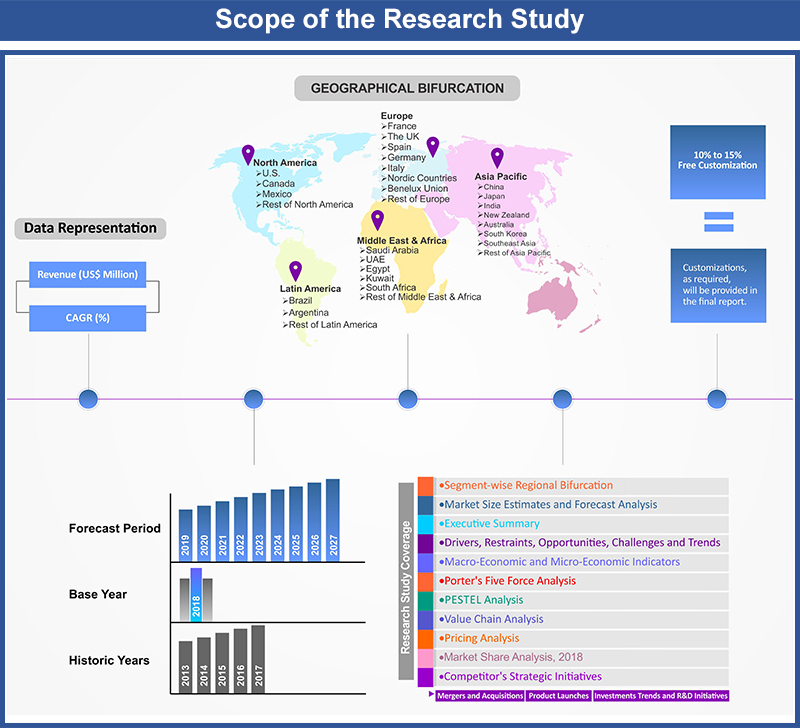Aerospace 3D Printing Market by Material Type (Plastics, Metals, Ceramics, Others); by Material Application (Engine, Structural Components, Space Components); by Form (Filament, Powder, Liquid); by Process (Binder Jetting, Material Extrusion, Direct Energy Deposition, Powder Bed Fusion, Sheet Lamination, Material Jetting, Vat Photo-Polymerization); by Printers Technology (Stereo Lithography (SLA), Selective Laser Sintering (SLS), Fuse Deposition Modeling (FDM), Direct Metal Laser Sintering (DMLS), Polyjet Printing, Inkjet Printing, Laminated Object Manufacturing, Digital Light Processing (DLLP), Electron Beam Melting (EBM), Laser Metal Deposition (LMD), Continuous Liquid Interface Production (CLIP)); by Application (Aircraft, UAV, Spacecraft); by Regional Outlook (U.S., Rest of North America, France, UK, Germany, Spain, Italy, Rest of Europe, China, Japan, India, Southeast Asia, Rest of Asia Pacific, GCC Countries, Southern Africa, Rest of MEA, Brazil, Rest of Latin America) – Global Insights, Industry Trends, Price Trends, Growth, Size, Supply, Demand, Comparative Analysis, Competitive Market Share and Forecast, 2018-2026
Industry Trends
3D printing of parts is a new technology that has come up with the possibility to change the way enterprises build new products, including parts for defense and aerospace. This new manufacturing process is known as 3D printing or additive manufacturing. This innovation includes producing physical objects by printing one layer at any given moment, using special material deposition devices and computerized models. This present age 3D printing equipment has developed in a short span of time and is equipped for delivering complex components among various kinds of materials which includes aluminum, titanium, steel, and distinctive assortment of plastics. Along these lines, in view of its potential, 3D printing is gaining significance in different manufacturing and fabricating sectors. The Global Aerospace 3D Printing Market was valued at US$ 635.1 Mn in 2017 and is expected to reach US$ 2117.4 Mn by 2022.
Aerospace 3D Printing Market, by Material Application, 2017 & 2022 (USD Million)
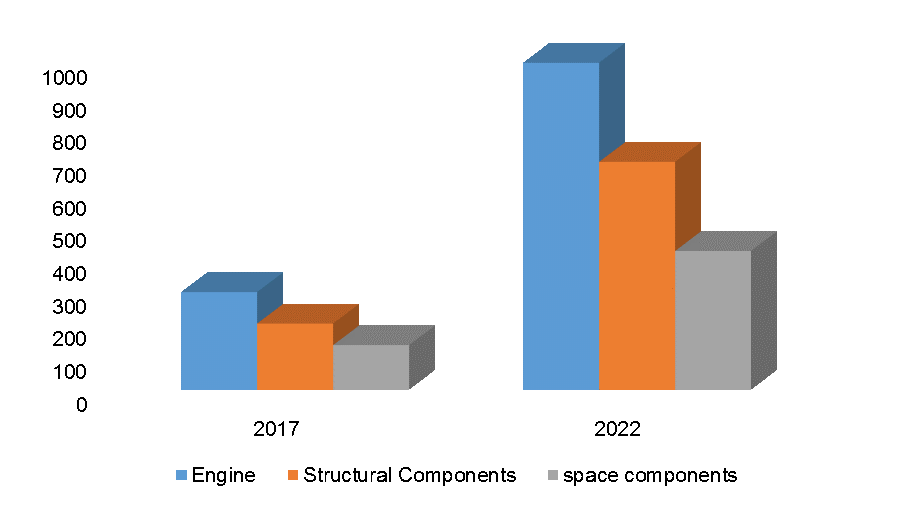
The aerospace sector recognizes the unique competence of 3D printing and is pursuing ways to exploit these competencies. For example, Boeing is utilizing 3D printing to manufacture plastic interior parts out of nylon and polyetherimide for their test evaluation and prototype units. Boeing is utilizing 3D printing technology to swiftly manufacture tools for making composite parts. Additionally, Pratt & Whitney aerospace company is investing extensively in a state-of-the-art 3D manufacturing center in association with the University of Connecticut.
One of the essential drivers in the market is miniaturization of jet engines. 3D printing not just adds to the general weight reduction of the aircraft yet, in addition, empowers miniaturization of aircraft components. This, in turn, brings about fuel proficiency and a lower working expense. At the point when a gas turbine uses pulsed injection fuel rather than a constant injection, the pressure in both the compressor and ignition chamber increases. This enables the design of smaller and lighter compressor systems, which saves a lot of fuel. Increasing demand for lightweight aircraft air ship parts and components from the aerospace industry is driving the development of the aerospace 3D printing market.
Aerospace 3D Printing Market, by Material Application
On the basis of material application, the space components segment represented the maximum share of the market during 2015 and will keep on dominating the market for the following couple of years. One of the central point adding to the development of this segment is the increasing demand for production of lightweight and smaller engine components.
Aerospace 3D Printing Market, by Region
On the basis of geography, North America holds the largest share of the market. In this region, 3D printing technology is for the most part used as a part of major industrial manufacturing sectors, for example, defense, aviation, aerospace, healthcare and so on. Persistent technological advancements in areas, for example, science, infrastructure, industries, and so forth are boosting the market for North America. Additionally, the market for aerospace 3D printing in the Asia Pacific is likewise anticipated to develop at a prime rate amid the estimated time frame.
Competitive Market Share
The report provides both, subjective and quantitative research of the market, as well as integrates worthy insights into the rational scenario and favored development methods adopted by the key contenders. The report also offers extensive research on the key players in this market and detailed insights on the competitiveness of these players. The key business strategies such as M&A, affiliations, collaborations, and contracts adopted by the major players are also recognized and analyzed in the report. For each company, the report recognizes their manufacturing base, competitors, product type, application and specification, pricing, and gross margin.
Some of the primary players of Global Aerospace 3D Printing Market are Stratasys Ltd., 3D Systems Corporation, The ExOne Company, EOS GmbH, Arcam AB, Ultimaker B.V., and Materialise NV, Airbus B.V., Boeing, Rolls-Royce (U.K.), Pratt & Whitney, and GE Aviation, among others.
Aerospace 3D Printing Industry Background
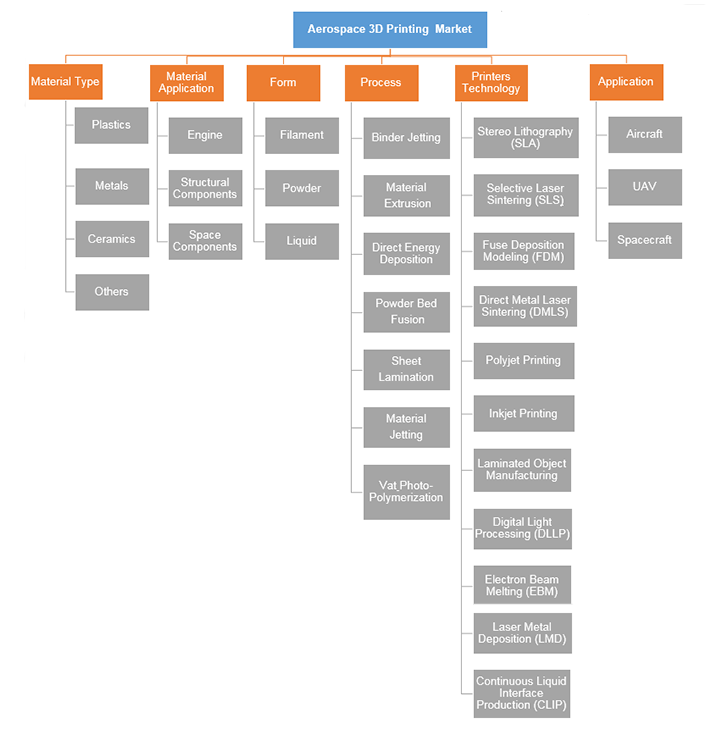
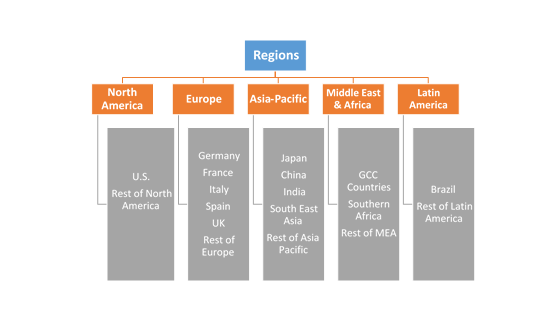
1. Introduction
1.1. Market Scope
1.2. Market Segmentation
1.3. Methodology
1.4. Assumptions
2. Aerospace 3D Printing Market Snapshot
3. Executive Summary: Aerospace 3D Printing Market
4. Qualitative Analysis: Aerospace 3D Printing Market
4.1. Introduction
4.1.1. Product Definition
4.1.2. Industry Development
4.2. Market Dynamics
4.2.1. Drivers
4.2.2. Restraints
4.2.3. Opportunities
4.3.
Trends in Aerospace 3D
Printing Market
4.3.1. Innovations in Materials Used for 3D Printing.
5. Global Aerospace 3D Printing Market Analysis and Forecasts,
2018 – 2026
5.1. Overview
5.1.1. Global Aerospace 3D Printing Market Revenue (US$ Mn) and
Forecasts
5.2. Global Market Revenue (US$ Mn) and Forecasts, By Material Type
5.2.1. Plastics
5.2.1.1. Definition
5.2.1.2. Market Penetration
5.2.1.3. Market Revenue Expected to Increase by 2026
5.2.1.4. Compound Annual Growth Rate (CAGR)
5.2.2. Metals
5.2.2.1. Definition
5.2.2.2. Market Penetration
5.2.2.3. Market Revenue Expected to Increase by 2026
5.2.2.4. Compound Annual Growth Rate (CAGR)
5.2.3. Ceramics
5.2.3.1. Definition
5.2.3.2. Market Penetration
5.2.3.3. Market Revenue Expected to Increase by 2026
5.2.3.4. Compound Annual Growth Rate (CAGR)
5.2.4. Others
5.2.4.1. Definition
5.2.4.2. Market Penetration
5.2.4.3. Market Revenue Expected to Increase by 2026
5.2.4.4. Compound Annual Growth Rate (CAGR)
5.3. Key Segment for Channeling Investments
5.3.1. By Material Type
6. Global Aerospace 3D Printing Market Analysis and Forecasts,
2018 – 2026
6.1. Overview
6.2. Global Aerospace 3D Printing Market Revenue (US$ Mn) and
Forecasts, By Material Application
6.2.1. Engine
6.2.1.1. Definition
6.2.1.2. Market Penetration
6.2.1.3. Market Revenue Expected to Increase by 2026
6.2.1.4. Compound Annual Growth Rate (CAGR)
6.2.2. Structural Components
6.2.2.1. Definition
6.2.2.2. Market Penetration
6.2.2.3. Market Revenue Expected to Increase by 2026
6.2.2.4. Compound Annual Growth Rate (CAGR)
6.2.3. Space Components
6.2.3.1. Definition
6.2.3.2. Market Penetration
6.2.3.3. Market Revenue Expected to Increase by 2026
6.2.3.4. Compound Annual Growth Rate (CAGR)
6.3. Key Segment for Channeling Investments
6.3.1. By Material Application
7. Global Aerospace 3D Printing Market Analysis and Forecasts,
2018 – 2026
7.1. Overview
7.2. Global Market Revenue (US$ Mn) and Forecasts, By Form
7.2.1. Filament
7.2.1.1. Definition
7.2.1.2. Market Penetration
7.2.1.3. Market Revenue Expected to Increase by 2026
7.2.1.4. Compound Annual Growth Rate (CAGR)
7.2.2. Powder
7.2.2.1. Definition
7.2.2.2. Market Penetration
7.2.2.3. Market Revenue Expected to Increase by 2026
7.2.2.4. Compound Annual Growth Rate (CAGR)
7.2.3. Liquid
7.2.3.1. Definition
7.2.3.2. Market Penetration
7.2.3.3. Market Revenue Expected to Increase by 2026
7.2.3.4. Compound Annual Growth Rate (CAGR)
7.3. Key Segment for Channeling Investments
7.3.1. By Form
8. Global Aerospace 3D Printing Market Analysis and Forecasts,
2018 – 2026
8.1. Overview
8.2. Global Aerospace 3D Printing Market Revenue (US$ Mn) and
Forecasts, By Process
8.2.1. Binder jetting
8.2.1.1. Definition
8.2.1.2. Market Penetration
8.2.1.3. Market Revenue Expected to Increase by 2026
8.2.1.4. Compound Annual Growth Rate (CAGR)
8.2.2. Material extrusion
8.2.2.1. Definition
8.2.2.2. Market Penetration
8.2.2.3. Market Revenue Expected to Increase by 2026
8.2.2.4. Compound Annual Growth Rate (CAGR)
8.2.3. Direct energy deposition
8.2.3.1. Definition
8.2.3.2. Market Penetration
8.2.3.3. Market Revenue Expected to Increase by 2026
8.2.3.4. Compound Annual Growth Rate (CAGR)
8.2.4. Powder bed fusion
8.2.4.1. Definition
8.2.4.2. Market Penetration
8.2.4.3. Market Revenue Expected to Increase by 2026
8.2.4.4. Compound Annual Growth Rate (CAGR)
8.2.5. Sheet lamination
8.2.5.1. Definition
8.2.5.2. Market Penetration
8.2.5.3. Market Revenue Expected to Increase by 2026
8.2.5.4. Compound Annual Growth Rate (CAGR)
8.2.6. Material jetting
8.2.6.1. Definition
8.2.6.2. Market Penetration
8.2.6.3. Market Revenue Expected to Increase by 2026
8.2.6.4. Compound Annual Growth Rate (CAGR)
8.2.7. Vat photo-polymerization
8.2.7.1. Definition
8.2.7.2. Market Penetration
8.2.7.3. Market Revenue Expected to Increase by 2026
8.2.7.4. Compound Annual Growth Rate (CAGR)
8.3. Key Segment for Channeling Investments
8.3.1. By Process
9. Global Aerospace 3D Printing Market Analysis and Forecasts,
2018 – 2026
9.1. Overview
9.2. Global Aerospace 3D Printing Market Revenue (US$ Mn) and Forecasts,
By Printers Technology
9.2.1. Stereo lithography (SLA)
9.2.1.1. Definition
9.2.1.2. Market Penetration
9.2.1.3. Market Revenue Expected to Increase by 2026
9.2.1.4. Compound Annual Growth Rate (CAGR)
9.2.2. Selective Laser Sintering (SLS)
9.2.2.1. Definition
9.2.2.2. Market Penetration
9.2.2.3. Market Revenue Expected to Increase by 2026
9.2.2.4. Compound Annual Growth Rate (CAGR)
9.2.3. Fuse Deposition Modeling (FDM)
9.2.3.1. Definition
9.2.3.2. Market Penetration
9.2.3.3. Market Revenue Expected to Increase by 2026
9.2.3.4. Compound Annual Growth Rate (CAGR)
9.2.4. Direct Metal Laser Sintering (DMLS)
9.2.4.1. Definition
9.2.4.2. Market Penetration
9.2.4.3. Market Revenue Expected to Increase by 2026
9.2.4.4. Compound Annual Growth Rate (CAGR)
9.2.5. Polyjet Printing
9.2.5.1. Definition
9.2.5.2. Market Penetration
9.2.5.3. Market Revenue Expected to Increase by 2026
9.2.5.4. Compound Annual Growth Rate (CAGR)
9.2.6. Inkjet Printing
9.2.6.1. Definition
9.2.6.2. Market Penetration
9.2.6.3. Market Revenue Expected to Increase by 2026
9.2.6.4. Compound Annual Growth Rate (CAGR)
9.2.7. Laminated Object Manufacturing
9.2.7.1. Definition
9.2.7.2. Market Penetration
9.2.7.3. Market Revenue Expected to Increase by 2026
9.2.7.4. Compound Annual Growth Rate (CAGR)
9.2.8. Digital Light Processing (DLLP)
9.2.8.1. Definition
9.2.8.2. Market Penetration
9.2.8.3. Market Revenue Expected to Increase by 2026
9.2.8.4. Compound Annual Growth Rate (CAGR)
9.2.9. Electron Beam Melting (EBM)
9.2.9.1. Definition
9.2.9.2. Market Penetration
9.2.9.3. Market Revenue Expected to Increase by 2026
9.2.9.4. Compound Annual Growth Rate (CAGR)
9.2.10. Laser Metal Deposition (LMD)
9.2.10.1. Definition
9.2.10.2. Market Penetration
9.2.10.3. Market Revenue Expected to Increase by 2026
9.2.10.4. Compound Annual Growth Rate (CAGR)
9.2.11. Continuous Liquid Interface Production (CLIP)
9.2.11.1. Definition
9.2.11.2. Market Penetration
9.2.11.3. Market Revenue Expected to Increase by 2026
9.2.11.4. Compound Annual Growth Rate (CAGR)
9.3. Key Segment for Channeling Investments
9.3.1. By Printers Technology
10. Global Aerospace 3D Printing Market Analysis and Forecasts,
2018 – 2026
10.1. Overview
10.2. Global Aerospace 3D Printing Market Revenue (US$ Mn) and
Forecasts, By Application
10.2.1. Aircraft
10.2.1.1. Definition
10.2.1.2. Market Penetration
10.2.1.3. Market Revenue Expected to Increase by 2026
10.2.1.4. Compound Annual Growth Rate (CAGR)
10.2.2. UAV
10.2.2.1. Definition
10.2.2.2. Market Penetration
10.2.2.3. Market Revenue Expected to Increase by 2026
10.2.2.4. Compound Annual Growth Rate (CAGR)
10.2.3. Spacecraft
10.2.3.1. Definition
10.2.3.2. Market Penetration
10.2.3.3. Market Revenue Expected to Increase by 2026
10.2.3.4. Compound Annual Growth Rate (CAGR)
10.3. Key Segment for Channeling Investments
10.3.1. By Application
11. North America Aerospace 3D Printing Market Analysis and
Forecasts, 2018 – 2026
11.1. Overview
11.1.1. North America Market Revenue (US$ Mn)
11.2. North America Aerospace 3D Printing Market Revenue (US$ Mn)
and Forecasts, By Material Type
11.2.1. Plastics
11.2.2. Metals
11.2.3. Ceramics
11.2.4. Others
11.3. North America Aerospace 3D Printing Market Revenue (US$ Mn)
and Forecasts, By Material Application
11.3.1. Engine
11.3.2. Structural Components
11.3.3. Space Components
11.4. North America Aerospace 3D Printing Market Revenue (US$ Mn)
and Forecasts, By Form
11.4.1. Filament
11.4.2. Powder
11.4.3. Liquid
11.5. North America Aerospace 3D Printing Market Revenue (US$ Mn)
and Forecasts, By Process
11.5.1. Binder jetting
11.5.2. Material extrusion
11.5.3. Direct energy deposition
11.5.4. Powder bed fusion
11.5.5. Sheet lamination
11.5.6. Material jetting
11.5.7. Vat photo-polymerization
11.6. North America Aerospace 3D Printing Market Revenue (US$ Mn)
and Forecasts, By Printers Technology
11.6.1. Stereo lithography (SLA)
11.6.2. Selective Laser Sintering (SLS)
11.6.3. Fuse Deposition Modeling (FDM)
11.6.4. Direct Metal Laser Sintering (DMLS)
11.6.5. Polyjet Printing
11.6.6. Inkjet Printing
11.6.7. Laminated Object Manufacturing
11.6.8. Digital Light Processing (DLLP)
11.6.9. Electron Beam Melting (EBM)
11.6.10. Laser Metal Deposition (LMD)
11.6.11. Continuous Liquid Interface Production (CLIP)
11.7. North America Aerospace 3D Printing Market Revenue (US$ Mn)
and Forecasts, By Application
11.7.1. Aircraft
11.7.2. UAV
11.7.3. Spacecraft
11.8. North America Aerospace 3D Printing Market Revenue (US$ Mn)
and Forecasts, By Country
11.8.1. U.S.
11.8.1.1. U.S. Market Revenue (US$ Mn) and Forecasts, By Material Type
11.8.1.1.1. Plastics
11.8.1.1.2. Metals
11.8.1.1.3. Ceramics
11.8.1.1.4. Others
11.8.1.2. U.S. Aerospace 3D Printing Market Revenue (US$ Mn) and
Forecasts, By Material Application
11.8.1.2.1. Engine
11.8.1.2.2. Structural Components
11.8.1.2.3. Space Components
11.8.1.3. U.S. Aerospace 3D Printing Market Revenue (US$ Mn) and
Forecasts, By Form
11.8.1.3.1. Filament
11.8.1.3.2. Powder
11.8.1.3.3. Liquid
11.8.1.4. U.S. Aerospace 3D Printing Market Revenue (US$ Mn) and
Forecasts, By Process
11.8.1.4.1. Binder jetting
11.8.1.4.2. Material extrusion
11.8.1.4.3. Direct energy deposition
11.8.1.4.4. Powder bed fusion
11.8.1.4.5. Sheet lamination
11.8.1.4.6. Material jetting
11.8.1.4.7. Vat photo-polymerization
11.8.1.5. U.S. Aerospace 3D Printing Market Revenue (US$ Mn) and
Forecasts, By Printers Technology
11.8.1.5.1. Stereo lithography (SLA)
11.8.1.5.2. Selective Laser Sintering (SLS)
11.8.1.5.3. Fuse Deposition Modeling (FDM)
11.8.1.5.4. Direct Metal Laser Sintering (DMLS)
11.8.1.5.5. Polyjet Printing
11.8.1.5.6. Inkjet Printing
11.8.1.5.7. Laminated Object Manufacturing
11.8.1.5.8. Digital Light Processing (DLLP)
11.8.1.5.9. Electron Beam Melting (EBM)
11.8.1.5.10. Laser Metal Deposition (LMD)
11.8.1.5.11. Continuous Liquid Interface Production (CLIP)
11.8.1.6. U.S. Aerospace 3D Printing Market Revenue (US$ Mn) and
Forecasts, By Application
11.8.1.6.1. Aircraft
11.8.1.6.2. UAV
11.8.1.6.3. Spacecraft
11.8.2. Rest of North America
11.8.2.1. Rest of North America Aerospace 3D Printing Market Revenue
(US$ Mn) and Forecasts, By Material Type
11.8.2.1.1. Plastics
11.8.2.1.2. Metals
11.8.2.1.3. Ceramics
11.8.2.1.4. Others
11.8.2.2. Rest of North America Aerospace 3D Printing Market Revenue
(US$ Mn) and Forecasts, By Material Application
11.8.2.2.1. Engine
11.8.2.2.2. Structural Components
11.8.2.2.3. Space Components
11.8.2.3. Rest of North America Aerospace 3D Printing Market Revenue
(US$ Mn) and Forecasts, By Form
11.8.2.3.1. Filament
11.8.2.3.2. Powder
11.8.2.3.3. Liquid
11.8.2.4. Rest of North America Aerospace 3D Printing Market Revenue
(US$ Mn) and Forecasts, By Process
11.8.2.4.1. Binder jetting
11.8.2.4.2. Material extrusion
11.8.2.4.3. Direct energy deposition
11.8.2.4.4. Powder bed fusion
11.8.2.4.5. Sheet lamination
11.8.2.4.6. Material jetting
11.8.2.4.7. Vat photo-polymerization
11.8.2.5. Rest of North America Aerospace 3D Printing Market Revenue
(US$ Mn) and Forecasts, By Printers Technology
11.8.2.5.1. Stereo lithography (SLA)
11.8.2.5.2. Selective Laser Sintering (SLS)
11.8.2.5.3. Fuse Deposition Modeling (FDM)
11.8.2.5.4. Direct Metal Laser Sintering (DMLS)
11.8.2.5.5. Polyjet Printing
11.8.2.5.6. Inkjet Printing
11.8.2.5.7. Laminated Object Manufacturing
11.8.2.5.8. Digital Light Processing (DLLP)
11.8.2.5.9. Electron Beam Melting (EBM)
11.8.2.5.10. Laser Metal Deposition (LMD)
11.8.2.5.11. Continuous Liquid Interface Production (CLIP)
11.8.2.6. Rest of North America Aerospace 3D Printing Market Revenue
(US$ Mn) and Forecasts, By Application
11.8.2.6.1. Aircraft
11.8.2.6.2. UAV
11.8.2.6.3. Spacecraft
11.9. Key Segment for Channeling Investments
11.9.1. By Country
11.9.2. By Material Type
11.9.3. By Material Application
11.9.4. By Form
11.9.5. By Process
11.9.6. By Printers Technology
11.9.7. By Application
12. Europe Aerospace 3D Printing Market Analysis and Forecasts,
2018 – 2026
12.1. Overview
12.1.1. Europe Market Revenue (US$ Mn)
12.2. Europe Aerospace 3D Printing Market Revenue (US$ Mn) and
Forecasts, By Material Type
12.2.1. Plastics
12.2.2. Metals
12.2.3. Ceramics
12.2.4. Others
12.3. Europe Aerospace 3D Printing Market Revenue (US$ Mn) and
Forecasts, By Material Application
12.3.1. Engine
12.3.2. Structural Components
12.3.3. Space Components
12.4. Europe Aerospace 3D Printing Market Revenue (US$ Mn) and
Forecasts, By Form
12.4.1. Filament
12.4.2. Powder
12.4.3. Liquid
12.5. Europe Aerospace 3D Printing Market Revenue (US$ Mn) and
Forecasts, By Process
12.5.1. Binder jetting
12.5.2. Material extrusion
12.5.3. Direct energy deposition
12.5.4. Powder bed fusion
12.5.5. Sheet lamination
12.5.6. Material jetting
12.5.7. Vat photo-polymerization
12.6. Europe Aerospace 3D Printing Market Revenue (US$ Mn) and
Forecasts, By Printers Technology
12.6.1. Stereo lithography (SLA)
12.6.2. Selective Laser Sintering (SLS)
12.6.3. Fuse Deposition Modeling (FDM)
12.6.4. Direct Metal Laser Sintering (DMLS)
12.6.5. Polyjet Printing
12.6.6. Inkjet Printing
12.6.7. Laminated Object Manufacturing
12.6.8. Digital Light Processing (DLLP)
12.6.9. Electron Beam Melting (EBM)
12.6.10. Laser Metal Deposition (LMD)
12.6.11. Continuous Liquid Interface
Production (CLIP)
12.7. Europe Aerospace 3D Printing Market Revenue (US$ Mn) and
Forecasts, By Application
12.7.1. Aircraft
12.7.2. UAV
12.7.3. Spacecraft
12.8. Europe Aerospace 3D Printing Market Revenue (US$ Mn) and
Forecasts, By Country
12.8.1. France
12.8.1.1. France Market Revenue (US$ Mn) and Forecasts, By Material Type
12.8.1.1.1. Plastics
12.8.1.1.2. Metals
12.8.1.1.3. Ceramics
12.8.1.1.4. Others
12.8.1.2. France Aerospace 3D Printing Market Revenue (US$ Mn) and
Forecasts, By Material Application
12.8.1.2.1. Engine
12.8.1.2.2. Structural Components
12.8.1.2.3. Space Components
12.8.1.3. France Aerospace 3D Printing Market Revenue (US$ Mn) and
Forecasts, By Form
12.8.1.3.1. Filament
12.8.1.3.2. Powder
12.8.1.3.3. Liquid
12.8.1.4. France Aerospace 3D Printing Market Revenue (US$ Mn) and
Forecasts, By Process
12.8.1.4.1. Binder jetting
12.8.1.4.2. Material extrusion
12.8.1.4.3. Direct energy deposition
12.8.1.4.4. Powder bed fusion
12.8.1.4.5. Sheet lamination
12.8.1.4.6. Material jetting
12.8.1.4.7. Vat photo-polymerization
12.8.1.5. France Aerospace 3D Printing Market Revenue (US$ Mn) and
Forecasts, By Printers Technology
12.8.1.5.1. Stereo lithography (SLA)
12.8.1.5.2. Selective Laser Sintering (SLS)
12.8.1.5.3. Fuse Deposition Modeling (FDM)
12.8.1.5.4. Direct Metal Laser Sintering (DMLS)
12.8.1.5.5. Polyjet Printing
12.8.1.5.6. Inkjet Printing
12.8.1.5.7. Laminated Object Manufacturing
12.8.1.5.8. Digital Light Processing (DLLP)
12.8.1.5.9. Electron Beam Melting (EBM)
12.8.1.5.10. Laser Metal Deposition (LMD)
12.8.1.5.11. Continuous Liquid Interface Production (CLIP)
12.8.1.6. France Aerospace 3D Printing Market Revenue (US$ Mn) and
Forecasts, By Application
12.8.1.6.1. Aircraft
12.8.1.6.2. UAV
12.8.1.6.3. Spacecraft
12.8.2. The UK
12.8.2.1. The UK Aerospace 3D Printing Market Revenue (US$ Mn) and
Forecasts, By Material Type
12.8.2.1.1. Plastics
12.8.2.1.2. Metals
12.8.2.1.3. Ceramics
12.8.2.1.4. Others
12.8.2.2. The UK Aerospace 3D Printing Market Revenue (US$ Mn) and
Forecasts, By Material Application
12.8.2.2.1. Engine
12.8.2.2.2. Structural Components
12.8.2.2.3. Space Components
12.8.2.3. The UK Aerospace 3D Printing Market Revenue (US$ Mn) and
Forecasts, By Form
12.8.2.3.1. Filament
12.8.2.3.2. Powder
12.8.2.3.3. Liquid
12.8.2.4. The UK Aerospace 3D Printing Market Revenue (US$ Mn) and
Forecasts, By Process
12.8.2.4.1. Binder jetting
12.8.2.4.2. Material extrusion
12.8.2.4.3. Direct energy deposition
12.8.2.4.4. Powder bed fusion
12.8.2.4.5. Sheet lamination
12.8.2.4.6. Material jetting
12.8.2.4.7. Vat photo-polymerization
12.8.2.5. The UK Aerospace 3D Printing Market Revenue (US$ Mn) and
Forecasts, By Printers Technology
12.8.2.5.1. Stereo lithography (SLA)
12.8.2.5.2. Selective Laser Sintering (SLS)
12.8.2.5.3. Fuse Deposition Modeling (FDM)
12.8.2.5.4. Direct Metal Laser Sintering (DMLS)
12.8.2.5.5. Polyjet Printing
12.8.2.5.6. Inkjet Printing
12.8.2.5.7. Laminated Object Manufacturing
12.8.2.5.8. Digital Light Processing (DLLP)
12.8.2.5.9. Electron Beam Melting (EBM)
12.8.2.5.10. Laser Metal Deposition (LMD)
12.8.2.5.11. Continuous Liquid Interface Production (CLIP)
12.8.2.6. The UK Aerospace 3D Printing Market Revenue (US$ Mn) and
Forecasts, By Application
12.8.2.6.1. Aircraft
12.8.2.6.2. UAV
12.8.2.6.3. Spacecraft
12.8.3. Spain
12.8.3.1. Spain Aerospace 3D Printing Market Revenue (US$ Mn) and
Forecasts, By Material Type
12.8.3.1.1. Plastics
12.8.3.1.2. Metals
12.8.3.1.3. Ceramics
12.8.3.1.4. Others
12.8.3.2. Spain Aerospace 3D Printing Market Revenue (US$ Mn) and
Forecasts, By Material Application
12.8.3.2.1. Engine
12.8.3.2.2. Structural Components
12.8.3.2.3. Space Components
12.8.3.3. Spain Aerospace 3D Printing Market Revenue (US$ Mn) and
Forecasts, By Form
12.8.3.3.1. Filament
12.8.3.3.2. Powder
12.8.3.3.3. Liquid
12.8.3.4. Spain Aerospace 3D Printing Market Revenue (US$ Mn) and
Forecasts, By Process
12.8.3.4.1. Binder jetting
12.8.3.4.2. Material extrusion
12.8.3.4.3. Direct energy deposition
12.8.3.4.4. Powder bed fusion
12.8.3.4.5. Sheet lamination
12.8.3.4.6. Material jetting
12.8.3.4.7. Vat photo-polymerization
12.8.3.5. Spain Aerospace 3D Printing Market Revenue (US$ Mn) and
Forecasts, By Printers Technology
12.8.3.5.1. Stereo lithography (SLA)
12.8.3.5.2. Selective Laser Sintering (SLS)
12.8.3.5.3. Fuse Deposition Modeling (FDM)
12.8.3.5.4. Direct Metal Laser Sintering (DMLS)
12.8.3.5.5. Polyjet Printing
12.8.3.5.6. Inkjet Printing
12.8.3.5.7. Laminated Object Manufacturing
12.8.3.5.8. Digital Light Processing (DLLP)
12.8.3.5.9. Electron Beam Melting (EBM)
12.8.3.5.10. Laser Metal Deposition (LMD)
12.8.3.5.11. Continuous Liquid Interface Production (CLIP)
12.8.3.6. Spain Aerospace 3D Printing Market Revenue (US$ Mn) and
Forecasts, By Application
12.8.3.6.1. Aircraft
12.8.3.6.2. UAV
12.8.3.6.3. Spacecraft
12.8.4. Germany
12.8.4.1. Germany Aerospace 3D Printing Market Revenue (US$ Mn) and
Forecasts, By Material Type
12.8.4.1.1. Plastics
12.8.4.1.2. Metals
12.8.4.1.3. Ceramics
12.8.4.1.4. Others
12.8.4.2. Germany Aerospace 3D Printing Market Revenue (US$ Mn) and
Forecasts, By Material Application
12.8.4.2.1. Engine
12.8.4.2.2. Structural Components
12.8.4.2.3. Space Components
12.8.4.3. Germany Aerospace 3D Printing Market Revenue (US$ Mn) and
Forecasts, By Form
12.8.4.3.1. Filament
12.8.4.3.2. Powder
12.8.4.3.3. Liquid
12.8.4.4. Germany Aerospace 3D Printing Market Revenue (US$ Mn) and Forecasts,
By Process
12.8.4.4.1. Binder jetting
12.8.4.4.2. Material extrusion
12.8.4.4.3. Direct energy deposition
12.8.4.4.4. Powder bed fusion
12.8.4.4.5. Sheet lamination
12.8.4.4.6. Material jetting
12.8.4.4.7. Vat photo-polymerization
12.8.4.5. Germany Aerospace 3D Printing Market Revenue (US$ Mn) and
Forecasts, By Printers Technology
12.8.4.5.1. Stereo lithography (SLA)
12.8.4.5.2. Selective Laser Sintering (SLS)
12.8.4.5.3. Fuse Deposition Modeling (FDM)
12.8.4.5.4. Direct Metal Laser Sintering (DMLS)
12.8.4.5.5. Polyjet Printing
12.8.4.5.6. Inkjet Printing
12.8.4.5.7. Laminated Object Manufacturing
12.8.4.5.8. Digital Light Processing (DLLP)
12.8.4.5.9. Electron Beam Melting (EBM)
12.8.4.5.10. Laser Metal Deposition (LMD)
12.8.4.5.11. Continuous Liquid Interface Production (CLIP)
12.8.4.6. Germany Aerospace 3D Printing Market Revenue (US$ Mn) and
Forecasts, By Application
12.8.4.6.1. Aircraft
12.8.4.6.2. UAV
12.8.4.6.3. Spacecraft
12.8.5. Italy
12.8.5.1. Italy Aerospace 3D Printing Market Revenue (US$ Mn) and
Forecasts, By Material Type
12.8.5.1.1. Plastics
12.8.5.1.2. Metals
12.8.5.1.3. Ceramics
12.8.5.1.4. Others
12.8.5.2. Italy Aerospace 3D Printing Market Revenue (US$ Mn) and
Forecasts, By Material Application
12.8.5.2.1. Engine
12.8.5.2.2. Structural Components
12.8.5.2.3. Space Components
12.8.5.3. Italy Aerospace 3D Printing Market Revenue (US$ Mn) and
Forecasts, By Form
12.8.5.3.1. Filament
12.8.5.3.2. Powder
12.8.5.3.3. Liquid
12.8.5.4. Italy Aerospace 3D Printing Market Revenue (US$ Mn) and
Forecasts, By Process
12.8.5.4.1. Binder jetting
12.8.5.4.2. Material extrusion
12.8.5.4.3. Direct energy deposition
12.8.5.4.4. Powder bed fusion
12.8.5.4.5. Sheet lamination
12.8.5.4.6. Material jetting
12.8.5.4.7. Vat photo-polymerization
12.8.5.5. Italy Aerospace 3D Printing Market Revenue (US$ Mn) and
Forecasts, By Printers Technology
12.8.5.5.1. Stereo lithography (SLA)
12.8.5.5.2. Selective Laser Sintering (SLS)
12.8.5.5.3. Fuse Deposition Modeling (FDM)
12.8.5.5.4. Direct Metal Laser Sintering (DMLS)
12.8.5.5.5. Polyjet Printing
12.8.5.5.6. Inkjet Printing
12.8.5.5.7. Laminated Object Manufacturing
12.8.5.5.8. Digital Light Processing (DLLP)
12.8.5.5.9. Electron Beam Melting (EBM)
12.8.5.5.10. Laser Metal Deposition (LMD)
12.8.5.5.11. Continuous Liquid Interface Production (CLIP)
12.8.5.6. Italy Aerospace 3D Printing Market Revenue (US$ Mn) and
Forecasts, By Application
12.8.5.6.1. Aircraft
12.8.5.6.2. UAV
12.8.5.6.3. Spacecraft
12.8.6. Rest of Europe
12.8.6.1. Rest of Europe Aerospace 3D Printing Market Revenue (US$ Mn)
and Forecasts, By Material Type
12.8.6.1.1. Plastics
12.8.6.1.2. Metals
12.8.6.1.3. Ceramics
12.8.6.1.4. Others
12.8.6.2. Rest of Europe Aerospace 3D Printing Market Revenue (US$ Mn)
and Forecasts, By Material Application
12.8.6.2.1. Engine
12.8.6.2.2. Structural Components
12.8.6.2.3. Space Components
12.8.6.3. Rest of Europe Aerospace 3D Printing Market Revenue (US$ Mn)
and Forecasts, By Form
12.8.6.3.1. Filament
12.8.6.3.2. Powder
12.8.6.3.3. Liquid
12.8.6.4. Rest of Europe Aerospace 3D Printing Market Revenue (US$ Mn)
and Forecasts, By Process
12.8.6.4.1. Binder jetting
12.8.6.4.2. Material extrusion
12.8.6.4.3. Direct energy deposition
12.8.6.4.4. Powder bed fusion
12.8.6.4.5. Sheet lamination
12.8.6.4.6. Material jetting
12.8.6.4.7. Vat photo-polymerization
12.8.6.5. Rest of Europe Aerospace 3D Printing Market Revenue (US$ Mn)
and Forecasts, By Printers Technology
12.8.6.5.1. Stereo lithography (SLA)
12.8.6.5.2. Selective Laser Sintering (SLS)
12.8.6.5.3. Fuse Deposition Modeling (FDM)
12.8.6.5.4. Direct Metal Laser Sintering (DMLS)
12.8.6.5.5. Polyjet Printing
12.8.6.5.6. Inkjet Printing
12.8.6.5.7. Laminated Object Manufacturing
12.8.6.5.8. Digital Light Processing (DLLP)
12.8.6.5.9. Electron Beam Melting (EBM)
12.8.6.5.10.
Laser Metal Deposition (LMD)
12.8.6.5.11.
Continuous Liquid Interface
Production (CLIP)
12.8.6.6. Rest of Europe Aerospace 3D Printing Market Revenue (US$ Mn)
and Forecasts, By Application
12.8.6.6.1. Aircraft
12.8.6.6.2. UAV
12.8.6.6.3. Spacecraft
12.9. Key Segment for Channeling Investments
12.9.1. By Country
12.9.2. By Material Type
12.9.3. By Material Application
12.9.4. By Form
12.9.5. By Process
12.9.6. By Printers Technology
12.9.7. By Application
13. Asia Pacific Aerospace 3D Printing Market Analysis and
Forecasts, 2018 – 2026
13.1. Overview
13.1.1. Asia Pacific Market Revenue (US$ Mn)
13.2. Asia Pacific Aerospace 3D Printing Market Revenue (US$ Mn) and
Forecasts, By Material Type
13.2.1. Plastics
13.2.2. Metals
13.2.3. Ceramics
13.2.4. Others
13.3. Asia Pacific Aerospace 3D Printing Market Revenue (US$ Mn) and
Forecasts, By Material Application
13.3.1. Engine
13.3.2. Structural Components
13.3.3. Space Components
13.4. Asia Pacific Aerospace 3D Printing Market Revenue (US$ Mn) and
Forecasts, By Form
13.4.1. Filament
13.4.2. Powder
13.4.3. Liquid
13.5. Asia Pacific Aerospace 3D Printing Market Revenue (US$ Mn) and
Forecasts, By Process
13.5.1. Binder jetting
13.5.2. Material extrusion
13.5.3. Direct energy deposition
13.5.4. Powder bed fusion
13.5.5. Sheet lamination
13.5.6. Material jetting
13.5.7. Vat photo-polymerization
13.6. Asia Pacific Aerospace 3D Printing Market Revenue (US$ Mn) and
Forecasts, By Printers Technology
13.6.1. Stereo lithography (SLA)
13.6.2. Selective Laser Sintering (SLS)
13.6.3. Fuse Deposition Modeling (FDM)
13.6.4. Direct Metal Laser Sintering (DMLS)
13.6.5. Polyjet Printing
13.6.6. Inkjet Printing
13.6.7. Laminated Object Manufacturing
13.6.8. Digital Light Processing (DLLP)
13.6.9. Electron Beam Melting (EBM)
13.6.10. Laser Metal Deposition (LMD)
13.6.11. Continuous Liquid Interface Production (CLIP)
13.7. Asia Pacific Aerospace 3D Printing Market Revenue (US$ Mn) and
Forecasts, By Application
13.7.1. Aircraft
13.7.2. UAV
13.7.3. Spacecraft
13.8. Asia Pacific Aerospace 3D Printing Market Revenue (US$ Mn) and
Forecasts, By Country
13.8.1. China
13.8.1.1. China Aerospace 3D Printing Market Revenue (US$ Mn) and
Forecasts, By Material Type
13.8.1.1.1. Plastics
13.8.1.1.2. Metals
13.8.1.1.3. Ceramics
13.8.1.1.4. Others
13.8.1.2. China Aerospace 3D Printing Market Revenue (US$ Mn) and
Forecasts, By Material Application
13.8.1.2.1. Engine
13.8.1.2.2. Structural Components
13.8.1.2.3. Space Components
13.8.1.3. China Aerospace 3D Printing Market Revenue (US$ Mn) and
Forecasts, By Form
13.8.1.3.1. Filament
13.8.1.3.2. Powder
13.8.1.3.3. Liquid
13.8.1.4. China Aerospace 3D Printing Market Revenue (US$ Mn) and
Forecasts, By Process
13.8.1.4.1. Binder jetting
13.8.1.4.2. Material extrusion
13.8.1.4.3. Direct energy deposition
13.8.1.4.4. Powder bed fusion
13.8.1.4.5. Sheet lamination
13.8.1.4.6. Material jetting
13.8.1.4.7. Vat photo-polymerization
13.8.1.5. China Aerospace 3D Printing Market Revenue (US$ Mn) and
Forecasts, By Printers Technology
13.8.1.5.1. Stereo lithography (SLA)
13.8.1.5.2. Selective Laser Sintering (SLS)
13.8.1.5.3. Fuse Deposition Modeling (FDM)
13.8.1.5.4. Direct Metal Laser Sintering (DMLS)
13.8.1.5.5. Polyjet Printing
13.8.1.5.6. Inkjet Printing
13.8.1.5.7. Laminated Object Manufacturing
13.8.1.5.8. Digital Light Processing (DLLP)
13.8.1.5.9. Electron Beam Melting (EBM)
13.8.1.5.10. Laser Metal Deposition (LMD)
13.8.1.5.11. Continuous Liquid Interface Production (CLIP)
13.8.1.6. China Aerospace 3D Printing Market Revenue (US$ Mn) and
Forecasts, By Application
13.8.1.6.1. Aircraft
13.8.1.6.2. UAV
13.8.1.6.3. Spacecraft
13.8.2. Japan
13.8.2.1. Japan Aerospace 3D Printing Market Revenue (US$ Mn) and
Forecasts, By Material Type
13.8.2.1.1. Plastics
13.8.2.1.2. Metals
13.8.2.1.3. Ceramics
13.8.2.1.4. Others
13.8.2.2. Japan Aerospace 3D Printing Market Revenue (US$ Mn) and
Forecasts, By Material Application
13.8.2.2.1. Engine
13.8.2.2.2. Structural Components
13.8.2.2.3. Space Components
13.8.2.3. Japan Aerospace 3D Printing Market Revenue (US$ Mn) and
Forecasts, By Form
13.8.2.3.1. Filament
13.8.2.3.2. Powder
13.8.2.3.3. Liquid
13.8.2.4. Japan Aerospace 3D Printing Market Revenue (US$ Mn) and
Forecasts, By Process
13.8.2.4.1. Binder jetting
13.8.2.4.2. Material extrusion
13.8.2.4.3. Direct energy deposition
13.8.2.4.4. Powder bed fusion
13.8.2.4.5. Sheet lamination
13.8.2.4.6. Material jetting
13.8.2.4.7. Vat photo-polymerization
13.8.2.5. Japan Aerospace 3D Printing Market Revenue (US$ Mn) and
Forecasts, By Printers Technology
13.8.2.5.1. Stereo lithography (SLA)
13.8.2.5.2. Selective Laser Sintering (SLS)
13.8.2.5.3. Fuse Deposition Modeling (FDM)
13.8.2.5.4. Direct Metal Laser Sintering (DMLS)
13.8.2.5.5. Polyjet Printing
13.8.2.5.6. Inkjet Printing
13.8.2.5.7. Laminated Object Manufacturing
13.8.2.5.8. Digital Light Processing (DLLP)
13.8.2.5.9. Electron Beam Melting (EBM)
13.8.2.5.10. Laser Metal Deposition (LMD)
13.8.2.5.11. Continuous Liquid Interface Production (CLIP)
13.8.2.6. Japan Aerospace 3D Printing Market Revenue (US$ Mn) and
Forecasts, By Application
13.8.2.6.1. Aircraft
13.8.2.6.2. UAV
13.8.2.6.3. Spacecraft
13.8.3. India
13.8.3.1. India Aerospace 3D Printing Market Revenue (US$ Mn) and
Forecasts, By Material Type
13.8.3.1.1. Plastics
13.8.3.1.2. Metals
13.8.3.1.3. Ceramics
13.8.3.1.4. Others
13.8.3.2. India Aerospace 3D Printing Market Revenue (US$ Mn) and
Forecasts, By Material Application
13.8.3.2.1. Engine
13.8.3.2.2. Structural Components
13.8.3.2.3. Space Components
13.8.3.3. India Aerospace 3D Printing Market Revenue (US$ Mn) and
Forecasts, By Form
13.8.3.3.1. Filament
13.8.3.3.2. Powder
13.8.3.3.3. Liquid
13.8.3.4. India Aerospace 3D Printing Market Revenue (US$ Mn) and
Forecasts, By Process
13.8.3.4.1. Binder jetting
13.8.3.4.2. Material extrusion
13.8.3.4.3. Direct energy deposition
13.8.3.4.4. Powder bed fusion
13.8.3.4.5. Sheet lamination
13.8.3.4.6. Material jetting
13.8.3.4.7. Vat photo-polymerization
13.8.3.5. India Aerospace 3D Printing Market Revenue (US$ Mn) and
Forecasts, By Printers Technology
13.8.3.5.1. Stereo lithography (SLA)
13.8.3.5.2. Selective Laser Sintering (SLS)
13.8.3.5.3. Fuse Deposition Modeling (FDM)
13.8.3.5.4. Direct Metal Laser Sintering (DMLS)
13.8.3.5.5. Polyjet Printing
13.8.3.5.6. Inkjet Printing
13.8.3.5.7. Laminated Object Manufacturing
13.8.3.5.8. Digital Light Processing (DLLP)
13.8.3.5.9. Electron Beam Melting (EBM)
13.8.3.5.10.
Laser Metal Deposition (LMD)
13.8.3.5.11.
Continuous Liquid Interface
Production (CLIP)
13.8.3.6. India Aerospace 3D Printing Market Revenue (US$ Mn) and
Forecasts, By Application
13.8.3.6.1. Aircraft
13.8.3.6.2. UAV
13.8.3.6.3. Spacecraft
13.8.4. Southeast Asia
13.8.4.1. Southeast Asia Aerospace 3D Printing Market Revenue (US$ Mn)
and Forecasts, By Material Type
13.8.4.1.1. Plastics
13.8.4.1.2. Metals
13.8.4.1.3. Ceramics
13.8.4.1.4. Others
13.8.4.2. Southeast Asia Aerospace 3D Printing Market Revenue (US$ Mn)
and Forecasts, By Material Application
13.8.4.2.1. Engine
13.8.4.2.2. Structural Components
13.8.4.2.3. Space Components
13.8.4.3. Southeast Asia Aerospace 3D Printing Market Revenue (US$ Mn)
and Forecasts, By Form
13.8.4.3.1. Filament
13.8.4.3.2. Powder
13.8.4.3.3. Liquid
13.8.4.4. Southeast Asia Aerospace 3D Printing Market Revenue (US$ Mn)
and Forecasts, By Process
13.8.4.4.1. Binder jetting
13.8.4.4.2. Material extrusion
13.8.4.4.3. Direct energy deposition
13.8.4.4.4. Powder bed fusion
13.8.4.4.5. Sheet lamination
13.8.4.4.6. Material jetting
13.8.4.4.7. Vat photo-polymerization
13.8.4.5. Southeast Asia Aerospace 3D Printing Market Revenue (US$ Mn)
and Forecasts, By Printers Technology
13.8.4.5.1. Stereo lithography (SLA)
13.8.4.5.2. Selective Laser Sintering (SLS)
13.8.4.5.3. Fuse Deposition Modeling (FDM)
13.8.4.5.4. Direct Metal Laser Sintering (DMLS)
13.8.4.5.5. Polyjet Printing
13.8.4.5.6. Inkjet Printing
13.8.4.5.7. Laminated Object Manufacturing
13.8.4.5.8. Digital Light Processing (DLLP)
13.8.4.5.9. Electron Beam Melting (EBM)
13.8.4.5.10. Laser Metal Deposition (LMD)
13.8.4.5.11. Continuous Liquid Interface Production (CLIP)
13.8.4.6. Southeast Asia Aerospace 3D Printing Market Revenue (US$ Mn)
and Forecasts, By Application
13.8.4.6.1. Aircraft
13.8.4.6.2. UAV
13.8.4.6.3. Spacecraft
13.8.5. Rest of Asia Pacific
13.8.5.1. Rest of Asia Pacific Aerospace 3D Printing Market Revenue (US$
Mn) and Forecasts, By Material Type
13.8.5.1.1. Plastics
13.8.5.1.2. Metals
13.8.5.1.3. Ceramics
13.8.5.1.4. Others
13.8.5.2. Rest of Asia Pacific Aerospace 3D Printing Market Revenue (US$
Mn) and Forecasts, By Material Application
13.8.5.2.1. Engine
13.8.5.2.2. Structural Components
13.8.5.2.3. Space Components
13.8.5.3. Rest of Asia Pacific Aerospace 3D Printing Market Revenue (US$
Mn) and Forecasts, By Form
13.8.5.3.1. Filament
13.8.5.3.2. Powder
13.8.5.3.3. Liquid
13.8.5.4. Rest of Asia Pacific Aerospace 3D Printing Market Revenue (US$
Mn) and Forecasts, By Process
13.8.5.4.1. Binder jetting
13.8.5.4.2. Material extrusion
13.8.5.4.3. Direct energy deposition
13.8.5.4.4. Powder bed fusion
13.8.5.4.5. Sheet lamination
13.8.5.4.6. Material jetting
13.8.5.4.7. Vat photo-polymerization
13.8.5.5. Rest of Asia Pacific Aerospace 3D Printing Market Revenue (US$
Mn) and Forecasts, By Printers Technology
13.8.5.5.1. Stereo lithography (SLA)
13.8.5.5.2. Selective Laser Sintering (SLS)
13.8.5.5.3. Fuse Deposition Modeling (FDM)
13.8.5.5.4. Direct Metal Laser Sintering (DMLS)
13.8.5.5.5. Polyjet Printing
13.8.5.5.6. Inkjet Printing
13.8.5.5.7. Laminated Object Manufacturing
13.8.5.5.8. Digital Light Processing (DLLP)
13.8.5.5.9. Electron Beam Melting (EBM)
13.8.5.5.10.
Laser Metal Deposition (LMD)
13.8.5.5.11.
Continuous Liquid Interface
Production (CLIP)
13.8.5.6. Rest of Asia Pacific Aerospace 3D Printing Market Revenue (US$
Mn) and Forecasts, By Application
13.8.5.6.1. Aircraft
13.8.5.6.2. UAV
13.8.5.6.3. Spacecraft
13.9. Key Segment for Channeling Investments
13.9.1. By Country
13.9.2. By Material Type
13.9.3. By Material Application
13.9.4. By Form
13.9.5. By Process
13.9.6. By Printers Technology
13.9.7. By Application
14. Middle East and Africa
Aerospace 3D Printing Market Analysis and Forecasts, 2018 – 2026
14.1. Overview
14.1.1. Middle East and Africa Market Revenue (US$ Mn)
14.2. Middle East and Africa Aerospace 3D Printing Market Revenue
(US$ Mn) and Forecasts, By Material Type
14.2.1. Plastics
14.2.2. Metals
14.2.3. Ceramics
14.2.4. Others
14.3. Middle East and Africa Aerospace 3D Printing Market Revenue
(US$ Mn) and Forecasts, By Material Application
14.3.1. Engine
14.3.2. Structural Components
14.3.3. Space Components
14.4. Middle East and Africa Aerospace 3D Printing Market Revenue
(US$ Mn) and Forecasts, By Form
14.4.1. Filament
14.4.2. Powder
14.4.3. Liquid
14.5. Middle East and Africa Aerospace 3D Printing Market Revenue
(US$ Mn) and Forecasts, By Process
14.5.1. Binder jetting
14.5.2. Material extrusion
14.5.3. Direct energy deposition
14.5.4. Powder bed fusion
14.5.5. Sheet lamination
14.5.6. Material jetting
14.5.7. Vat photo-polymerization
14.6. Middle East and Africa Aerospace 3D Printing Market Revenue
(US$ Mn) and Forecasts, By Printers Technology
14.6.1. Stereo lithography (SLA)
14.6.2. Selective Laser Sintering (SLS)
14.6.3. Fuse Deposition Modeling (FDM)
14.6.4. Direct Metal Laser Sintering (DMLS)
14.6.5. Polyjet Printing
14.6.6. Inkjet Printing
14.6.7. Laminated Object Manufacturing
14.6.8. Digital Light Processing (DLLP)
14.6.9. Electron Beam Melting (EBM)
14.6.10.Laser
Metal Deposition (LMD)
14.6.11.Continuous
Liquid Interface Production (CLIP)
14.7. Middle East and Africa Aerospace 3D Printing Market Revenue
(US$ Mn) and Forecasts, By Application
14.7.1. Aircraft
14.7.2. UAV
14.7.3. Spacecraft
14.8. Middle East and Africa Aerospace 3D Printing Market Revenue
(US$ Mn) and Forecasts, By Country
14.8.1. GCC Countries
14.8.1.1. GCC Countries Aerospace 3D Printing Market Revenue (US$ Mn)
and Forecasts, By Material Type
14.8.1.1.1. Plastics
14.8.1.1.2. Metals
14.8.1.1.3. Ceramics
14.8.1.1.4. Others
14.8.1.2. GCC Countries Aerospace 3D Printing Market Revenue (US$ Mn)
and Forecasts, By Material Application
14.8.1.2.1. Engine
14.8.1.2.2. Structural Components
14.8.1.2.3. Space Components
14.8.1.3. GCC Countries Aerospace 3D Printing Market Revenue (US$ Mn)
and Forecasts, By Form
14.8.1.3.1. Filament
14.8.1.3.2. Powder
14.8.1.3.3. Liquid
14.8.1.4. GCC Countries Aerospace 3D Printing Market Revenue (US$ Mn)
and Forecasts, By Process
14.8.1.4.1. Binder jetting
14.8.1.4.2. Material extrusion
14.8.1.4.3. Direct energy deposition
14.8.1.4.4. Powder bed fusion
14.8.1.4.5. Sheet lamination
14.8.1.4.6. Material jetting
14.8.1.4.7. Vat photo-polymerization
14.8.1.5. GCC Countries Aerospace 3D Printing Market Revenue (US$ Mn)
and Forecasts, By Printers Technology
14.8.1.5.1. Stereo lithography (SLA)
14.8.1.5.2. Selective Laser Sintering (SLS)
14.8.1.5.3. Fuse Deposition Modeling (FDM)
14.8.1.5.4. Direct Metal Laser Sintering (DMLS)
14.8.1.5.5. Polyjet Printing
14.8.1.5.6. Inkjet Printing
14.8.1.5.7. Laminated Object Manufacturing
14.8.1.5.8. Digital Light Processing (DLLP)
14.8.1.5.9. Electron Beam Melting (EBM)
14.8.1.5.10. Laser Metal Deposition (LMD)
14.8.1.5.11. Continuous Liquid Interface Production (CLIP)
14.8.1.6. GCC Countries Aerospace 3D Printing Market Revenue (US$ Mn)
and Forecasts, By Application
14.8.1.6.1. Aircraft
14.8.1.6.2. UAV
14.8.1.6.3. Spacecraft
14.8.2. Southern Africa
14.8.2.1. Southern Africa Aerospace 3D Printing Market Revenue (US$ Mn)
and Forecasts, By Material Type
14.8.2.1.1. Plastics
14.8.2.1.2. Metals
14.8.2.1.3. Ceramics
14.8.2.1.4. Others
14.8.2.2. Southern Africa Aerospace 3D Printing Market Revenue (US$ Mn)
and Forecasts, By Material Application
14.8.2.2.1. Engine
14.8.2.2.2. Structural Components
14.8.2.2.3. Space Components
14.8.2.3. Southern Africa Aerospace 3D Printing Market Revenue (US$ Mn)
and Forecasts, By Form
14.8.2.3.1. Filament
14.8.2.3.2. Powder
14.8.2.3.3. Liquid
14.8.2.4. Southern Africa Aerospace 3D Printing Market Revenue (US$ Mn)
and Forecasts, By Process
14.8.2.4.1. Binder jetting
14.8.2.4.2. Material extrusion
14.8.2.4.3. Direct energy deposition
14.8.2.4.4. Powder bed fusion
14.8.2.4.5. Sheet lamination
14.8.2.4.6. Material jetting
14.8.2.4.7. Vat photo-polymerization
14.8.2.5. Southern Africa Aerospace 3D Printing Market Revenue (US$ Mn)
and Forecasts, By Printers Technology
14.8.2.5.1. Stereo lithography (SLA)
14.8.2.5.2. Selective Laser Sintering (SLS)
14.8.2.5.3. Fuse Deposition Modeling (FDM)
14.8.2.5.4. Direct Metal Laser Sintering (DMLS)
14.8.2.5.5. Polyjet Printing
14.8.2.5.6. Inkjet Printing
14.8.2.5.7. Laminated Object Manufacturing
14.8.2.5.8. Digital Light Processing (DLLP)
14.8.2.5.9. Electron Beam Melting (EBM)
14.8.2.5.10. Laser Metal Deposition (LMD)
14.8.2.5.11. Continuous Liquid Interface Production (CLIP)
14.8.2.6. Southern Africa Aerospace 3D Printing Market Revenue (US$ Mn)
and Forecasts, By Application
14.8.2.6.1. Aircraft
14.8.2.6.2. UAV
14.8.2.6.3. Spacecraft
14.8.3. Rest of MEA
14.8.3.1. Rest of MEA Aerospace 3D Printing Market Revenue (US$ Mn) and
Forecasts, By Material Type
14.8.3.1.1. Plastics
14.8.3.1.2. Metals
14.8.3.1.3. Ceramics
14.8.3.1.4. Others
14.8.3.2. Rest of MEA Aerospace 3D Printing Market Revenue (US$ Mn) and
Forecasts, By Material Application
14.8.3.2.1. Engine
14.8.3.2.2. Structural Components
14.8.3.2.3. Space Components
14.8.3.3. Rest of MEA Aerospace 3D Printing Market Revenue (US$ Mn) and
Forecasts, By Form
14.8.3.3.1. Filament
14.8.3.3.2. Powder
14.8.3.3.3. Liquid
14.8.3.4. Rest of MEA Aerospace 3D Printing Market Revenue (US$ Mn) and
Forecasts, By Process
14.8.3.4.1. Binder jetting
14.8.3.4.2. Material extrusion
14.8.3.4.3. Direct energy deposition
14.8.3.4.4. Powder bed fusion
14.8.3.4.5. Sheet lamination
14.8.3.4.6. Material jetting
14.8.3.4.7. Vat photo-polymerization
14.8.3.5. Rest of MEA Aerospace 3D Printing Market Revenue (US$ Mn) and
Forecasts, By Printers Technology
14.8.3.5.1. Stereo lithography (SLA)
14.8.3.5.2. Selective Laser Sintering (SLS)
14.8.3.5.3. Fuse Deposition Modeling (FDM)
14.8.3.5.4. Direct Metal Laser Sintering (DMLS)
14.8.3.5.5. Polyjet Printing
14.8.3.5.6. Inkjet Printing
14.8.3.5.7. Laminated Object Manufacturing
14.8.3.5.8. Digital Light Processing (DLLP)
14.8.3.5.9. Electron Beam Melting (EBM)
14.8.3.5.10.
Laser Metal Deposition (LMD)
14.8.3.5.11.
Continuous Liquid Interface
Production (CLIP)
14.8.3.6. Rest of MEA Aerospace 3D Printing Market Revenue (US$ Mn) and
Forecasts, By Application
14.8.3.6.1. Aircraft
14.8.3.6.2. UAV
14.8.3.6.3. Spacecraft
14.9. Key Segment for Channeling Investments
14.9.1. By Country
14.9.2. By Material Type
14.9.3. By Material Application
14.9.4. By Form
14.9.5. By Process
14.9.6. By Printers Technology
14.9.7. By Application
15. Latin America Aerospace 3D Printing Market Analysis and
Forecasts, 2018 – 2026
15.1. Overview
15.1.1. Latin America Market Revenue (US$ Mn)
15.2. Latin America Aerospace 3D Printing Market Revenue (US$ Mn)
and Forecasts, By Material Type
15.2.1. Plastics
15.2.2. Metals
15.2.3. Ceramics
15.2.4. Others
15.3. Latin America Aerospace 3D Printing Market Revenue (US$ Mn)
and Forecasts, By Material Application
15.3.1. Engine
15.3.2. Structural Components
15.3.3. Space Components
15.4. Latin America Aerospace 3D Printing Market Revenue (US$ Mn)
and Forecasts, By Form
15.4.1. Filament
15.4.2. Powder
15.4.3. Liquid
15.5. Latin America Aerospace 3D Printing Market Revenue (US$ Mn)
and Forecasts, By Process
15.5.1. Binder jetting
15.5.2. Material extrusion
15.5.3. Direct energy deposition
15.5.4. Powder bed fusion
15.5.5. Sheet lamination
15.5.6. Material jetting
15.5.7. Vat photo-polymerization
15.6. Latin America Aerospace 3D Printing Market Revenue (US$ Mn)
and Forecasts, By Printers Technology
15.6.1. Stereo lithography (SLA)
15.6.2. Selective Laser Sintering (SLS)
15.6.3. Fuse Deposition Modeling (FDM)
15.6.4. Direct Metal Laser Sintering (DMLS)
15.6.5. Polyjet Printing
15.6.6. Inkjet Printing
15.6.7. Laminated Object Manufacturing
15.6.8. Digital Light Processing (DLLP)
15.6.9. Electron Beam Melting (EBM)
15.6.10. Laser Metal Deposition (LMD)
15.6.11. Continuous Liquid Interface Production (CLIP)
15.7. Latin America Aerospace 3D Printing Market Revenue (US$ Mn)
and Forecasts, By Application
15.7.1. Aircraft
15.7.2. UAV
15.7.3. Spacecraft
15.8. Latin America Aerospace 3D Printing Market Revenue (US$ Mn)
and Forecasts, By Country
15.8.1. Brazil
15.8.1.1. Brazil Market Revenue (US$ Mn) and Forecasts, By Material Type
15.8.1.1.1. Plastics
15.8.1.1.2. Metals
15.8.1.1.3. Ceramics
15.8.1.1.4. Others
15.8.1.2. Brazil Aerospace 3D Printing Market Revenue (US$ Mn) and
Forecasts, By Material Application
15.8.1.2.1. Engine
15.8.1.2.2. Structural Components
15.8.1.2.3. Space Components
15.8.1.3. Brazil Aerospace 3D Printing Market Revenue (US$ Mn) and
Forecasts, By Form
15.8.1.3.1. Filament
15.8.1.3.2. Powder
15.8.1.3.3. Liquid
15.8.1.4. Brazil Aerospace 3D Printing Market Revenue (US$ Mn) and
Forecasts, By Process
15.8.1.4.1. Binder jetting
15.8.1.4.2. Material extrusion
15.8.1.4.3. Direct energy deposition
15.8.1.4.4. Powder bed fusion
15.8.1.4.5. Sheet lamination
15.8.1.4.6. Material jetting
15.8.1.4.7. Vat photo-polymerization
15.8.1.5. Brazil Aerospace 3D Printing Market Revenue (US$ Mn) and
Forecasts, By Printers Technology
15.8.1.5.1. Stereo lithography (SLA)
15.8.1.5.2. Selective Laser Sintering (SLS)
15.8.1.5.3. Fuse Deposition Modeling (FDM)
15.8.1.5.4. Direct Metal Laser Sintering (DMLS)
15.8.1.5.5. Polyjet Printing
15.8.1.5.6. Inkjet Printing
15.8.1.5.7. Laminated Object Manufacturing
15.8.1.5.8. Digital Light Processing (DLLP)
15.8.1.5.9. Electron Beam Melting (EBM)
15.8.1.5.10. Laser Metal Deposition (LMD)
15.8.1.5.11. Continuous Liquid Interface Production (CLIP)
15.8.1.6. Brazil Aerospace 3D Printing Market Revenue (US$ Mn) and
Forecasts, By Application
15.8.1.6.1. Aircraft
15.8.1.6.2. UAV
15.8.1.6.3. Spacecraft
15.8.2. Rest of Latin America
15.8.2.1. Rest of Latin America Aerospace 3D Printing Market Revenue
(US$ Mn) and Forecasts, By Material Type
15.8.2.1.1. Plastics
15.8.2.1.2. Metals
15.8.2.1.3. Ceramics
15.8.2.1.4. Others
15.8.2.2. Rest of Latin America Aerospace 3D Printing Market Revenue
(US$ Mn) and Forecasts, By Material Application
15.8.2.2.1. Engine
15.8.2.2.2. Structural Components
15.8.2.2.3. Space Components
15.8.2.3. Rest of Latin America Aerospace 3D Printing Market Revenue
(US$ Mn) and Forecasts, By Form
15.8.2.3.1. Filament
15.8.2.3.2. Powder
15.8.2.3.3. Liquid
15.8.2.4. Rest of Latin America Aerospace 3D Printing Market Revenue
(US$ Mn) and Forecasts, By Process
15.8.2.4.1. Binder jetting
15.8.2.4.2. Material extrusion
15.8.2.4.3. Direct energy deposition
15.8.2.4.4. Powder bed fusion
15.8.2.4.5. Sheet lamination
15.8.2.4.6. Material jetting
15.8.2.4.7. Vat photo-polymerization
15.8.2.5. Rest of Latin America Aerospace 3D Printing Market Revenue
(US$ Mn) and Forecasts, By Printers Technology
15.8.2.5.1. Stereo lithography (SLA)
15.8.2.5.2. Selective Laser Sintering (SLS)
15.8.2.5.3. Fuse Deposition Modeling (FDM)
15.8.2.5.4. Direct Metal Laser Sintering (DMLS)
15.8.2.5.5. Polyjet Printing
15.8.2.5.6. Inkjet Printing
15.8.2.5.7. Laminated Object Manufacturing
15.8.2.5.8. Digital Light Processing (DLLP)
15.8.2.5.9. Electron Beam Melting (EBM)
15.8.2.5.10.
Laser Metal Deposition (LMD)
15.8.2.5.11.
Continuous Liquid Interface
Production (CLIP)
15.8.2.6. Rest of Latin America Aerospace 3D Printing Market Revenue
(US$ Mn) and Forecasts, By Application
15.8.2.6.1. Aircraft
15.8.2.6.2. UAV
15.8.2.6.3. Spacecraft
15.9. Key Segment for Channeling Investments
15.9.1. By Country
15.9.2. By Material Type
15.9.3. By Material Application
15.9.4. By Form
15.9.5. By Process
15.9.6. By Printers Technology
15.9.7. By Application
16. Competitive Benchmarking
16.1. Player Positioning Analysis
16.2. Global Presence and Growth Strategies
17. Player Profiles
17.1. 3D Systems Corporation
17.1.1. Company Details
17.1.2. Company Overview
17.1.3. Product Offerings
17.1.4. Key Developments
17.1.5. Financial Analysis
17.1.6. SWOT Analysis
17.1.7. Business Strategies
17.2. AERIA Luxury Interiors
17.2.1. Company Details
17.2.2. Company Overview
17.2.3. Product Offerings
17.2.4. Key Developments
17.2.5. Financial Analysis
17.2.6. SWOT Analysis
17.2.7. Business Strategies
17.3. Aerojet Rocketdyne
17.3.1. Company Details
17.3.2. Company Overview
17.3.3. Product Offerings
17.3.4. Key Developments
17.3.5. Financial Analysis
17.3.6. SWOT Analysis
17.3.7. Business Strategies
17.4. Airbus
17.4.1. Company Details
17.4.2. Company Overview
17.4.3. Product Offerings
17.4.4. Key Developments
17.4.5. Financial Analysis
17.4.6. SWOT Analysis
17.4.7. Business Strategies
17.5. Arcam AB
17.5.1. Company Details
17.5.2. Company Overview
17.5.3. Product Offerings
17.5.4. Key Developments
17.5.5. Financial Analysis
17.5.6. SWOT Analysis
17.5.7. Business Strategies
17.6. Boeing
17.6.1. Company Details
17.6.2. Company Overview
17.6.3. Product Offerings
17.6.4. Key Developments
17.6.5. Financial Analysis
17.6.6. SWOT Analysis
17.6.7. Business Strategies
17.7. Envisiontec GmbH
17.7.1. Company Details
17.7.2. Company Overview
17.7.3. Product Offerings
17.7.4. Key Developments
17.7.5. Financial Analysis
17.7.6. SWOT Analysis
17.7.7. Business Strategies
17.8. EOS Gmbh
17.8.1. Company Details
17.8.2. Company Overview
17.8.3. Product Offerings
17.8.4. Key Developments
17.8.5. Financial Analysis
17.8.6. SWOT Analysis
17.8.7. Business Strategies
17.9. GE aviation
17.9.1. Company Details
17.9.2. Company Overview
17.9.3. Product Offerings
17.9.4. Key Developments
17.9.5. Financial Analysis
17.9.6. SWOT Analysis
17.9.7. Business Strategies
17.10. Hoganas AB
17.10.1. Company Details
17.10.2. Company Overview
17.10.3. Product Offerings
17.10.4. Key Developments
17.10.5. Financial Analysis
17.10.6. SWOT Analysis
17.10.7. Business Strategies
17.11. Honeywell International
17.11.1.
Company Details
17.11.2.
Company Overview
17.11.3.
Product Offerings
17.11.4.
Key Developments
17.11.5.
Financial Analysis
17.11.6.
SWOT Analysis
17.11.7.
Business Strategies
17.12. JBRND
17.12.1.
Company Details
17.12.2.
Company Overview
17.12.3.
Product Offerings
17.12.4.
Key Developments
17.12.5.
Financial Analysis
17.12.6.
SWOT Analysis
17.12.7.
Business Strategies
17.13. Materialise NV
17.13.1.
Company Details
17.13.2.
Company Overview
17.13.3.
Product Offerings
17.13.4.
Key Developments
17.13.5.
Financial Analysis
17.13.6.
SWOT Analysis
17.13.7.
Business Strategies
17.14. Moog
17.14.1.
Company Details
17.14.2.
Company Overview
17.14.3.
Product Offerings
17.14.4.
Key Developments
17.14.5.
Financial Analysis
17.14.6.
SWOT Analysis
17.14.7.
Business Strategies
17.15. MTU Aero Engines AG
17.15.1.
Company Details
17.15.2.
Company Overview
17.15.3.
Product Offerings
17.15.4.
Key Developments
17.15.5.
Financial Analysis
17.15.6.
SWOT Analysis
17.15.7.
Business Strategies
17.16. Norsk Titanium AS
17.16.1.
Company Details
17.16.2.
Company Overview
17.16.3.
Product Offerings
17.16.4.
Key Developments
17.16.5.
Financial Analysis
17.16.6.
SWOT Analysis
17.16.7.
Business Strategies
17.17. Organovo Holdings Inc
17.17.1.
Company Details
17.17.2.
Company Overview
17.17.3.
Product Offerings
17.17.4.
Key Developments
17.17.5.
Financial Analysis
17.17.6.
SWOT Analysis
17.17.7.
Business Strategies
17.18. Pratt & Whitney Aerospace Company
17.18.1.
Company Details
17.18.2.
Company Overview
17.18.3.
Product Offerings
17.18.4.
Key Developments
17.18.5.
Financial Analysis
17.18.6.
SWOT Analysis
17.18.7.
Business Strategies
17.19. Rolls-Royce
17.19.1.
Company Details
17.19.2.
Company Overview
17.19.3.
Product Offerings
17.19.4.
Key Developments
17.19.5.
Financial Analysis
17.19.6.
SWOT Analysis
17.19.7.
Business Strategies
17.20. Sandvik
17.20.1.
Company Details
17.20.2.
Company Overview
17.20.3.
Product Offerings
17.20.4.
Key Developments
17.20.5.
Financial Analysis
17.20.6.
SWOT Analysis
17.20.7.
Business Strategies
17.21. Solvay S.A.
17.21.1.
Company Details
17.21.2.
Company Overview
17.21.3.
Product Offerings
17.21.4.
Key Developments
17.21.5.
Financial Analysis
17.21.6.
SWOT Analysis
17.21.7.
Business Strategies
17.22. Stratasys Ltd.
17.22.1.
Company Details
17.22.2.
Company Overview
17.22.3.
Product Offerings
17.22.4.
Key Developments
17.22.5.
Financial Analysis
17.22.6.
SWOT Analysis
17.22.7.
Business Strategies
17.23. The Exone Company
17.23.1.
Company Details
17.23.2.
Company Overview
17.23.3.
Product Offerings
17.23.4.
Key Developments
17.23.5.
Financial Analysis
17.23.6.
SWOT Analysis
17.23.7.
Business Strategies
17.24. Ultimaker B.V.
17.24.1.
Company Details
17.24.2.
Company Overview
17.24.3.
Product Offerings
17.24.4.
Key Developments
17.24.5.
Financial Analysis
17.24.6.
SWOT Analysis
17.24.7.
Business Strategies
Note: This ToC is
tentative and can be changed according to the research study conducted during
the course of report completion.
At Absolute Markets Insights, we are engaged in building both global as well as country specific reports. As a result, the approach taken for deriving the estimation and forecast for a specific country is a bit unique and different in comparison to the global research studies. In this case, we not only study the concerned market factors & trends prevailing in a particular country (from secondary research) but we also tend to calculate the actual market size & forecast from the revenue generated from the market participants involved in manufacturing or distributing the any concerned product. These companies can also be service providers. For analyzing any country specifically, we do consider the growth factors prevailing under the states/cities/county for the same. For instance, if we are analyzing an industry specific to United States, we primarily need to study about the states present under the same(where the product/service has the highest growth). Similar analysis will be followed by other countries. Our scope of the report changes with different markets.
Our research study is mainly implement through a mix of both secondary and primary research. Various sources such as industry magazines, trade journals, and government websites and trade associations are reviewed for gathering precise data. Primary interviews are conducted to validate the market size derived from secondary research. Industry experts, major manufacturers and distributors are contacted for further validation purpose on the current market penetration and growth trends.
Prominent participants in our primary research process include:
- Key Opinion Leaders namely the CEOs, CSOs, VPs, purchasing managers, amongst others
- Research and development participants, distributors/suppliers and subject matter experts
Secondary Research includes data extracted from paid data sources:
- Reuters
- Factiva
- Bloomberg
- One Source
- Hoovers
Research Methodology
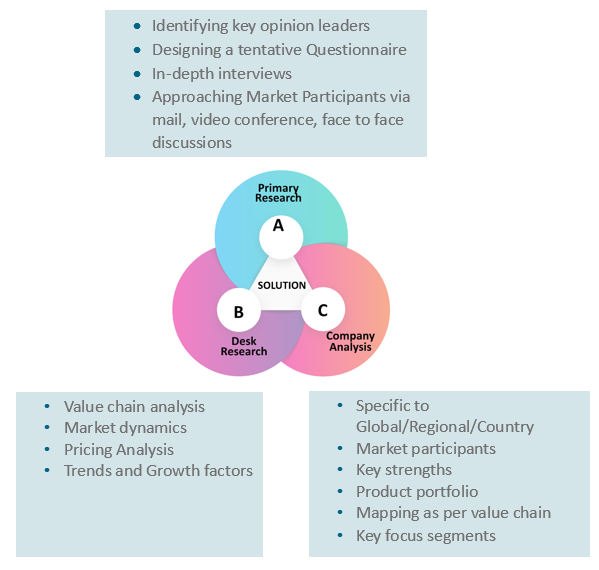
Key Inclusions
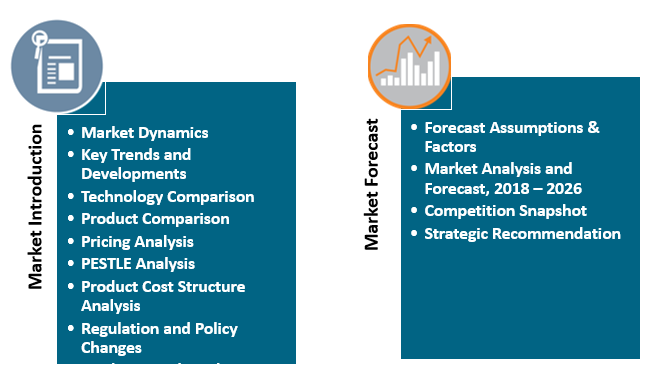
Reach to us
Call us on
+91-74002-42424
Drop us an email at
sales@absolutemarketsinsights.com
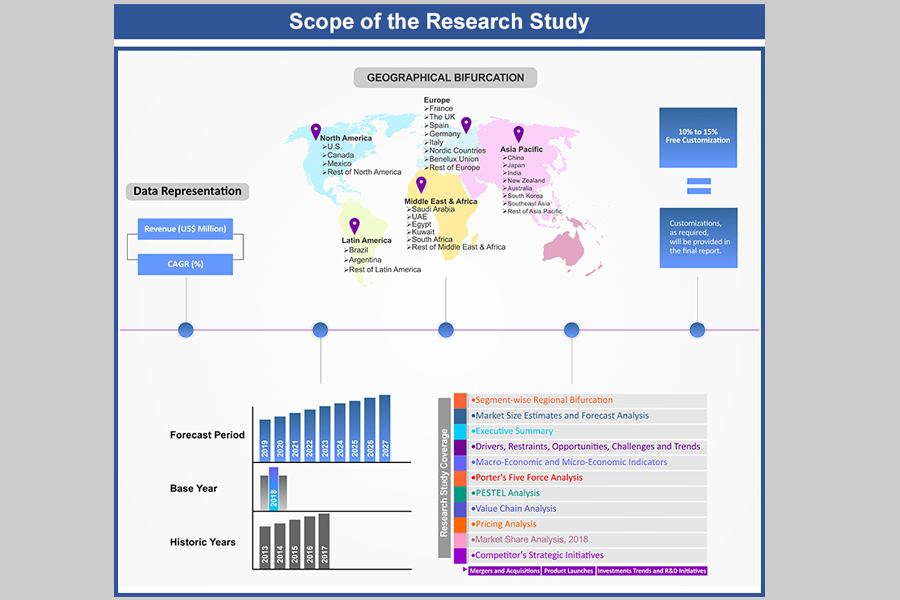
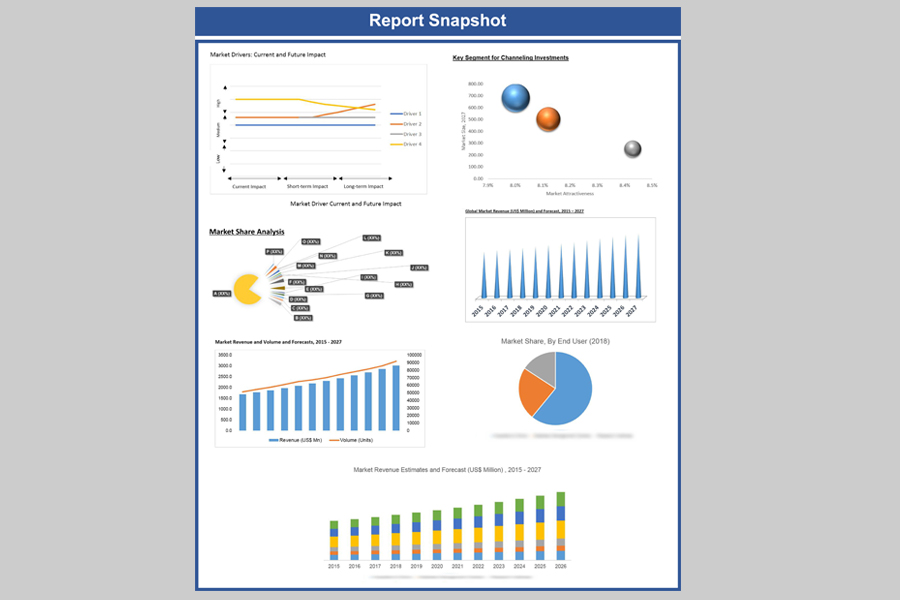
Why Absolute Markets Insights?
An effective strategy is the entity that influences a business to stand out of the crowd. An organization with a phenomenal strategy for success dependably has the edge over the rivals in the market. It offers the organizations a head start in planning their strategy. Absolute Market Insights is the new initiation in the industry that will furnish you with the lead your business needs. Absolute Market Insights is the best destination for your business intelligence and analytical solutions; essentially because our qualitative and quantitative sources of information are competent to give one-stop solutions. We inventively combine qualitative and quantitative research in accurate proportions to have the best report, which not only gives the most recent insights but also assists you to grow.


